GIGABYTE Server MD60-SC0 Motherboard Review: Haswell-EP with QSFP
by Ian Cutress on December 3, 2014 10:00 AM ESTCPU Benchmarks
Readers of our motherboard review section will have noted the trend in modern motherboards to implement a form of MultiCore Enhancement / Acceleration / Turbo (read our report here) on their motherboards. This does several things, including better benchmark results at stock settings (not entirely needed if overclocking is an end-user goal) at the expense of heat and temperature. It also gives in essence an automatic overclock which may be against what the user wants. Our testing methodology is ‘out-of-the-box’, with the latest public BIOS installed and XMP enabled, and thus subject to the whims of this feature. It is ultimately up to the motherboard manufacturer to take this risk – and manufacturers taking risks in the setup is something they do on every product (think C-state settings, USB priority, DPC Latency / monitoring priority, memory subtimings at JEDEC). Processor speed change is part of that risk, and ultimately if no overclocking is planned, some motherboards will affect how fast that shiny new processor goes and can be an important factor in the system build.
Point Calculations – 3D Movement Algorithm Test: link
3DPM is a self-penned benchmark, taking basic 3D movement algorithms used in Brownian Motion simulations and testing them for speed. High floating point performance, MHz and IPC wins in the single thread version, whereas the multithread version has to handle the threads and loves more cores.
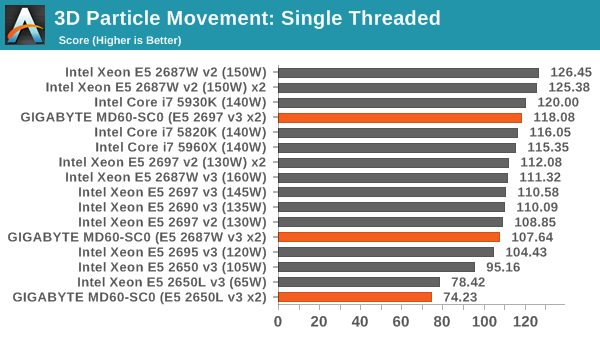
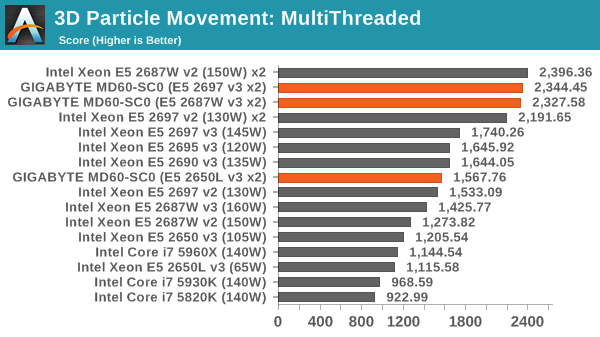
Compression – WinRAR 5.0.1: link
Our WinRAR test from 2013 is updated to the latest version of WinRAR at the start of 2014. We compress a set of 2867 files across 320 folders totaling 1.52 GB in size – 95% of these files are small typical website files, and the rest (90% of the size) are small 30 second 720p videos.
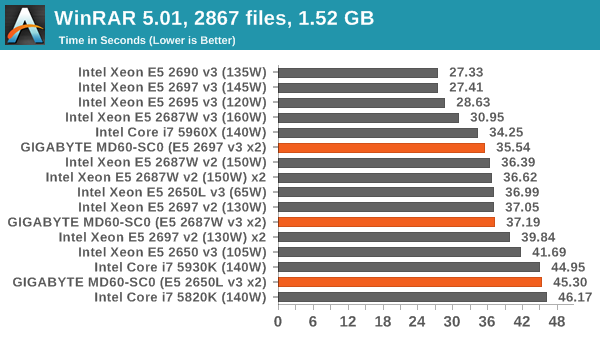
Image Manipulation – FastStone Image Viewer 4.9: link
Similarly to WinRAR, the FastStone test us updated for 2014 to the latest version. FastStone is the program I use to perform quick or bulk actions on images, such as resizing, adjusting for color and cropping. In our test we take a series of 170 images in various sizes and formats and convert them all into 640x480 .gif files, maintaining the aspect ratio. FastStone does not use multithreading for this test, and thus single threaded performance is often the winner.
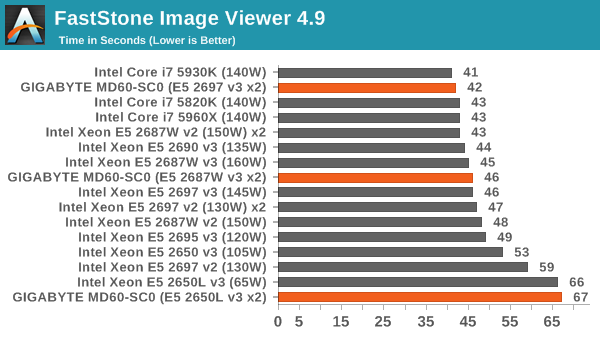
Video Conversion – Handbrake v0.9.9: link
Handbrake is a media conversion tool that was initially designed to help DVD ISOs and Video CDs into more common video formats. The principle today is still the same, primarily as an output for H.264 + AAC/MP3 audio within an MKV container. In our test we use the same videos as in the Xilisoft test, and results are given in frames per second.
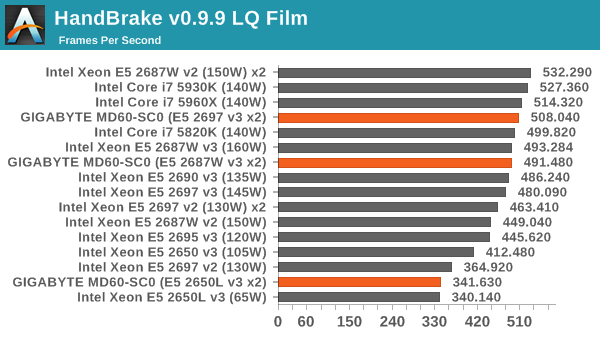
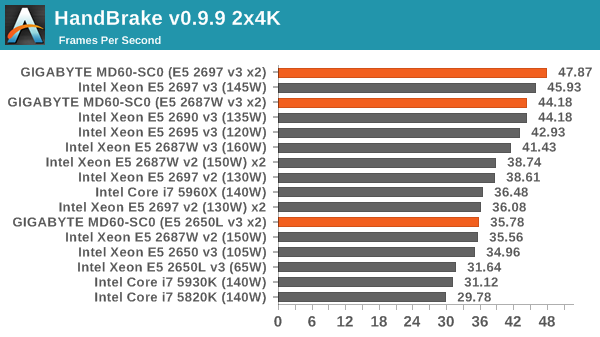
Rendering – PovRay 3.7: link
The Persistence of Vision RayTracer, or PovRay, is a freeware package for as the name suggests, ray tracing. It is a pure renderer, rather than modeling software, but the latest beta version contains a handy benchmark for stressing all processing threads on a platform. We have been using this test in motherboard reviews to test memory stability at various CPU speeds to good effect – if it passes the test, the IMC in the CPU is stable for a given CPU speed. As a CPU test, it runs for approximately 2-3 minutes on high end platforms.

Synthetic – 7-Zip 9.2: link
As an open source compression tool, 7-Zip is a popular tool for making sets of files easier to handle and transfer. The software offers up its own benchmark, to which we report the result.











17 Comments
View All Comments
PCTC2 - Wednesday, December 3, 2014 - link
Coming from the HPC space, seeing 512GB-1TB of RAM was pretty regular, but seeing 1.5TB-2TB was rare, but did occur. However, now with systems being able to have 6TB of RAM in a single 4U rack server is pretty incredible (4P servers with 96 DIMMs, Intel E7 v2 support).However, there are a few odd things about this board. For one, the QSFP+ is totally unnecessary, as it only supports 2x10GbE, and is not either 1) Infiniband or 2) 40GbE. Sure, with LACP, you could have bonded 20GbE, but you either need a splitter cable (QSFP+ to 4x SFP, with 2 SFP unusable) or a switch that supports multiple links over QSFP+ (a 40GbE with 10GbE breakout capabilities). Also, the decision to use the SFF-8087 connectors for the SATA and individual ports for SAS confounds me, as you lose the sideband support with individual cables, and onboard SATA doesn't support the sideband, thus losing some functionality with some backplanes. Also, the card Gigabyte advertises with this board is an LSI 2308, an HBA and not a full hardware RAID.
Some of Gigabyte's B2B systems have intrigued me, especially their 8x Tesla/Phi system in 2U, but this board just doesn't seem completely thought out.
jhh - Wednesday, December 3, 2014 - link
I suspect the QSFP was designed to support a Fortville, but they didn't get them qualified in time. That would get them a true 40 Gig port, or 4x10Gfackamato - Friday, December 5, 2014 - link
What's fortville?Cstefan - Friday, December 5, 2014 - link
Intel 40GBE QSFP+Nothing the consumer need worry over for a long time yet.
Klimax - Sunday, December 7, 2014 - link
With some results already available:http://www.tweaktown.com/reviews/6857/supermicro-a...
Cstefan - Friday, December 5, 2014 - link
I run multiple database servers with 2TB of ram. My next round is slated for 4TB. And absolutely no joke, they reversed the SAS and SATA connectors in a monumentally stupid move.ddriver - Wednesday, December 3, 2014 - link
Well, surprisingly no gaming benchmarks this time, but what's with the "professional performance" benches? How many professionals out there make their money on running cinebench? How about some real workstation workloads for a change?JeffFlanagan - Wednesday, December 3, 2014 - link
This isn't a workstation, or a gaming machine.ddriver - Wednesday, December 3, 2014 - link
I actually applauded the absence of gaming benchmarks this time. As for whether this is for a workstation machines, I'd say it is far more suited for a workstation than suited for running winrar and image viewing software.And just to note this "review" of a "serve" motherboard doesn't have a single server benchmark whatsoever...
mpbrede - Wednesday, December 3, 2014 - link
My usual gripe about acronyms that are not accompanied by an explanation when the term is first used. THis time aggravated by a typo, I'm sure."The system is based on the C612 chipset, which is similar to the consumer based X99 but with 2P related features, such as MTCP over PCIe."
I'm pretty sure you meant to type MCTP (Management Component Transport Protocol) and not the mTCP (microTCP?) or MTCP (Malaysian Technical Cooperation Programme or has something to do with Transport Layer Support for Highly Available Network
Services)